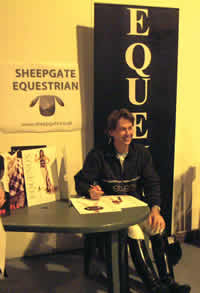 |
Olympic
rider reveals the secrets of his success
How
an evening with former Olympic dressage team member Emile
Faurie at Sheepgate Equestrian proved an inspiration for local
riders . . .
Emile
Faurie, one of Britain's leading international grand prix
riders and former double Olympic team member, provided a rare
insight into his successful training techniques at a well
attended lecture/demonstration at Sheepgate Equestrian last
week.
During
the evening, Emile, who rode three of his top horses currently
based at his yard in Gloucestershire, explained the importance
of consistent correct dressage training and demonstrated techniques
to encourage horses to work to the best of their abilities.
|
"I
like to try and keep things logical," he said. "My aim
is to explain things in simple terms to the horse because he's the
one who has to understand what I'm asking for and feel confident
that he can achieve it.
"I
start the horses in the same way every day - the warm up routine
is one of the most important aspects of daily training. Get that
right and you stand a better chance of encouraging the horse to
develop in his education and go and perform a good test."
The first horse in was Sheepgate Omero, ridden by resident trainer,
dressage competitor and List 2 judge Sarah Payne, who initiated
and organised the sell-out two-day masterclass with Emile, as well
as the lecture/demonstration.
This
attractive and supple Dutch-bred eight-year-old has proved a consistent
winner on the East Midlands circuit having qualified for next month's
regionals and is currently working at advanced medium level.
"I
like to see a horse walking like a cat and seeking the contact into
the bridle," explained Emile. "Riders need to be disciplined
enough to ensure that they begin every training session with 15-20
minutes in walk to warm up correctly.
"In the initial stages it's important to think about setting
a good rhythm, so that it almost has a hypnotic effect and that
the rider stays soft and encourages just a hint of flexion in the
neck, which should come from the wrists.
"Make
sure too that everything you ask for on the left rein, you also
repeat on the right. Later, we can move on to asking for shoulder
in and leg yielding, which should both form part of your regular
training regime rather than just a stand alone movement.
"In canter I also like to use a simple exercise where the rider
asks the horse to slowly spiral in from a 20m circle to a small
10m circle and then back out again - this really helps to encourage
the hind end to engage and improves the horse's self carriage and
allows an easier way of going."
Emile
introduced his audience to the first of his three current competition
rides.
Cachet, an eight-year-old Holstein/Thoroughbred, owned in partnership
with Mary Maghda, has been training with Emile for the past four
years.
"I
particularly like this type of breeding," explained Emile,
who went on to explain how Cachet had been introduced to higher
level work and flying changes. "He's elegant and responsive,
but he also has a Thoroughbred mind and can find all sorts of things
quite scarey. If he panics about something like banners or sudden
noises, I just pat him and reassure him that it's ok to go on.
"I'm also a great believe in allowing the horse to have a breather
in walk on a long rein in between being asked to work through different
exercises - that way you are giving him time to think about what
he's learnt and he look forward to stepping up to the next level."
The
next horse, La Primavera, a nine-year-old Holstein mare bought at
auction in Germany as a three-year-old, is owned by Emile. This
elegant mare recently won her first intermediare II test and looks
set to go all the way.
Last up was Anthony Bamford's elegant and big moving nine-year-old
Holstein Livello, who is in his first year of grand prix in Germany.
"I
warm up in exactly the same way as I do with a more novice horse
- shoulder in, counter canter and leg yielding," said Emile.
"I then up the stakes and ask for the higher level movements
- if he's frisky, that's fine, I just want her to take me willingly
and enjoy what he's doing.
"Horses
learn quickly if they are rewarded - if they don't understand something,
then repeat the question. Also, I don't like to use whips in everyday
training - they're not allowed to be carried in championships, so
why use them at home?"
"A
lot of riders make the mistake of asking for too much for too long
- 10 minutes of piaffe work is like jumping the Hickstead Derby
20 times - it takes a lot of effort and it's important to take this
into consideration when you're training your own horse. Don't take
advantage of him offering you some quality work by asking for more
and more and more - in other words, it's better to quit while you're
ahead and make the training an enjoyable experience for you both!"
The
evening also featured a popular raffle with prizes donated by Emile's
sponsor Equenox, the manufacturer of equestrian designs, with proceeds
of £300 going to the local Riding for the Disabled group.
Organiser
Sarah Payne, said: "Emile's approach to training horse and
rider is very user-friendly and the techniques can easily be applied
to those competing at every level.
"We
were delighted to welcome a rider and trainer of Emile's calibre
and experience and the feedback from both the lecture/demonstration
and the two-day riders' masterclass has been excellent.
"We are now looking at bringing some more top riders to Sheepgate
for further clinics in the future - watch this space!"
¢ For more information on future clinics log on to www.sheepgate.co.uk
.
|







